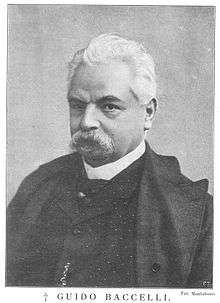Guido Baccelli
Guido Baccelli (1830–1916) was an Italian physician and statesman. One of the most renowned Italian physicians of the late 19th Century, he was Minister of Education of the then young Kingdom of Italy for six times and once Minister of Agriculture, Industry and Commerce, for a total period of almost ten years, between 1881 and 1903. He was a teacher to Augusto Murri. Together with Italian surgeon Francesco Durante, Baccelli promoted the construction of the Policlinico Umberto I in Rome.
Guido Baccelli | |
|---|---|
 | |
| Born | November 25, 1830 |
| Died | January 10, 1916 (aged 85) |
| Nationality | Italian |
| Scientific career | |
| Fields | medicine, politics |
| Institutions | Sapienza University of Rome |
Baccelli as a physician
Guido Baccelli spent almost his entire clinical and teaching life in the ancient, glorious but by that time decaying and unfit, mediaeval hospital of Santo Spirito in Saxia in Rome, between the Tiber and the Vatican City.[1] He was one of the Italian pioneers in the use of the stethoscope - the common people often referred to him as “the physician who examines the sick with the trumpet”[2] – of intravenous therapy and oxygen therapy.[3] In particular, he became famous when administered oxygen to the Italian King Victor Emmanuel II, prolonging his life for a few days during his last illness (a severe pneumonia).[4]
He gave relevant contributions to the struggle against malaria which, at that time, was one of the main health and social problems of the recently reunited Kingdom of Italy and of its Capital town. In 1878 – with the occasion of the Universal Exposition of Paris – he wrote an important state-of-the-art essay on this subject: La Malaria di Roma.[5] Guido Baccelli successively welcomed in his clinic of Santo Spirito the two future Nobel Prizes Alphonse Laveran (in 1882) and Camillo Golgi (in 1893) who were looking for confirmations of their theories about the origin and evolution of malaria, in the Campagna Romana, then scourged by the disease during summer and autumn time.[6] Baccelli was quite slow in accepting the anopheles as the sole vector in the transmission of the illness,[7] nevertheless he was a strong medical and political supporter of the Laws for the drainage of the Campagna Romana and the Pontine Marshes that - along with the free administration of quinine - significantly reduced the incidence of the disease in those areas.[8] Moreover, in 1889 he devised an effective treatment of the most serious cases of malaria with intravenous injections of quinine.[9]
Main writings
- Ascoltazione e percussione nella Scuola romana, Dalla Tipografia Forense, Roma 1857, pp. 10
- Patologia del cuore e dell’aorta, Dallo Stabilimento Tipografico, Roma 1863-1866, 3 voll.
- La Malaria di Roma, estratto dalla Monografia della Città di Roma e della Campagna Romana, Tipografia Elzeviriana, Roma 1878, pp. 51
- La via delle vene aperta ai medicamenti eroici, Tip. Nazionale Ditta G. Bertero e C., Roma 1907, pp. 66
Bibliography
- Anonymous, Guido Baccelli, M.D., BMJ 1916;1:114.2
- Alfredo Baccelli, Guido Baccelli. Ricordi, Edizioni "La Riforma Medica", Napoli 1931, pp. 114
- Luca Borghi, Guido Baccelli, in JOURNAL OF MEDICAL BIOGRAPHY (2012) 20 (2), p. 70
- Luca Borghi, Rome’s physician: Guido Baccelli and his legacy in the new Italian Capital, in MEDICINA NEI SECOLI. ARTE E SCIENZA, (2013) 25/2, pp. 395-414
- Luca Borghi, Il medico di Roma. Vita, morte e miracoli di Guido Baccelli (1830-1916), Armando Editore, Roma 2015, pp, 456
- Mario Crespi, Guido Baccelli, in Dizionario Biografico degli Italiani, Vol. 5 (1963)
- Giovanni Gorrini, Guido Baccelli. La vita, l'opera, il pensiero, Lattes, Torino 1916, pp. 318
- Fausto Pettinelli, Il Medico dei Re, CLD, Pontedera 2000, pp. 102
- Irene Quaresima, Guido Baccelli. Sintesi di una vita, Prospettive Edizioni, Roma 2002
References
- Borghi, Rome’s physician..., p. 396.
- Borghi, Rome’s physician..., p. 396.
- Borghi, Rome’s physician..., p. 396.
- Crespi, Guido Baccelli....
- Baccelli's essay can be read inside this Monograph "Monografia della Città di Roma...".
- Borghi, Rome’s physician..., p. 396.
- Borghi, Rome’s physician..., p. 397.
- Borghi, Rome’s physician..., p. 397.
- Gorrini, Guido Baccelli..., p. 114.